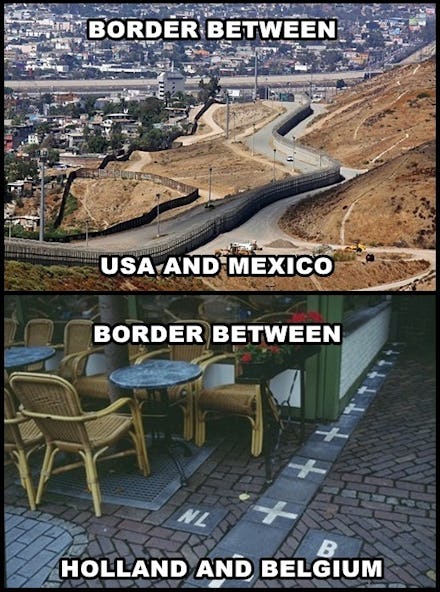One Meme Explains How Insane the U.S. - Mexico Border Has Become

A stark image: The border between the Netherlands and Belgium boasts an outdoor café. In complete juxtaposition, the U.S.-Mexico border looks more like a fortress. It's a powerful image that shows the lengths the United States will take to keep people out.
The border wall is just one strategy that the U.S. employs to combat illegal immigration. At a cost of $2.4 billion, the U.S. built up roughly 670 miles of fencing along the 2,000 mile-long border with Mexico. An estimated $90 billion has been spent by the American government on border control in the past decade. Annually, the U.S. is now spending around $18 million on border control, according to the Migration Policy Institute. The money goes to thousands of agents working the border and pays for drones, ground sensors to monitor land movement and surveillance, reports the Economist.
How they do it: The Netherlands-Belgium border has a different approach. The pictured border cradles two towns, Baarle-Nassau in the Netherlands and Baarle-Hertog in Belgium. The white-crossed line zig zags its way through the towns and houses and nationalities are based on the location of front doors.
There's also heavy cooperation. "The Belgians take responsibility for electricity and telephones, [and] the Dutch supply the gas and water," the BBC reports. Though citizens speak the same language, there are some rivalries between the two and each side maintains a healthy level of patriotism for their respective country.
The two countries maintain close relations politically, economically, militarily and culturally. Towards the end of World War II, Luxembourg, Belgium and the Netherlands created the Benelux Union (a play on the letters in each nation's name). As key trading partners for one another, Belgium and the Netherlands are also heavily reliant on each other for economic growth.
Meanwhile in the U.S.: In the United States, though, border control will continue to be dealt with firmly.
Texas Gov. Rick Perry, a staunch Republican, announced recently that he was beefing up security on the U.S.-Mexico border, bringing funding for the state up to $1.3 million a week. He justified the increase of money by saying, "Texas can't afford to wait for Washington to act on this crisis and we will not sit idly by while the safety and security of our citizens are threatened."
Even Democrats take border control strictly. Former Secretary of State Hillary Clinton was pressed in a CNN televised event about her position on allowing unaccompanied minors to remain in the U.S. after illegally coming into the country: "They should be sent back as soon as it can be determined who responsible adults in their families are, because – there are concerns about whether all of them can be sent back, but I think all of them that can be should be reunited with their families," Clinton said during a televised CNN "town hall."
She followed up with, "We have to send a clear message: Just because your child gets across the border, that doesn't mean the child gets to stay." That underlined President Obama's strategy in dealing with the 47,000 children who have crossed the U.S.-Mexico border since October 2013. Obama called the influx of immigrant children detained "an urgent humanitarian situation" and called FEMA to provide more housing and medical care for them.
Although U.S.-Mexico economic ties are different from the Belguim-Netherlands relationship, there is also far less collaboration between Mexico and the U.S. The skepticism Americans have for its southern neighbor is deep and policy shifts in this highly-charged region are not likely to happen any time soon.